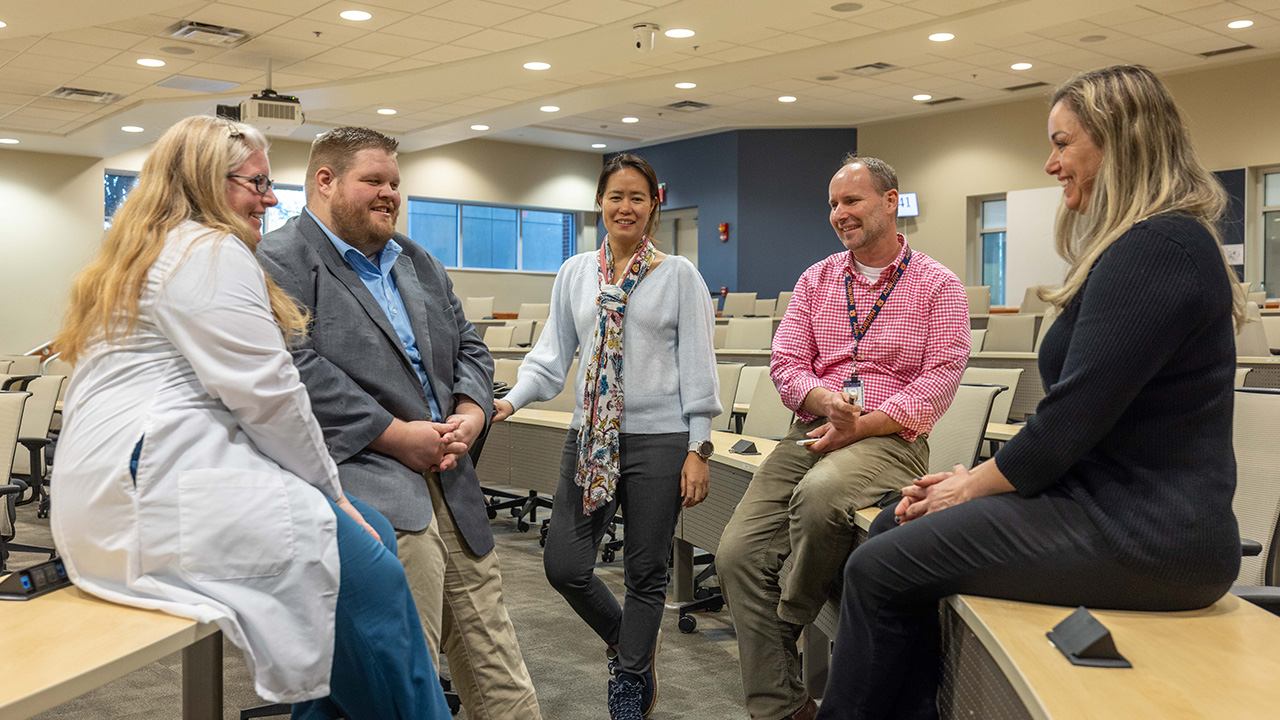content body

Amy Yanke, Ryan Gibson, Kamoltip Thungrat, Daniel Kroeger and Vinicia Biancardi (left to right) meet to discuss Auburn’s College of Veterinary Medicine’s NEROH Initiative.
It’s been little more than a year since Dr. Ryan Gibson wondered what would happen if students and faculty members in Auburn University’s College of Veterinary Medicine came together to talk about neuroscience for human and animal health.
His literal “shower thought,” as he calls it, led to Neuroscience Educators and Researchers in One Health (NEROH), a group that’s sparking new conversations and collaborations. And, as NEROH gains momentum, Gibson hopes it will give students, especially undergraduates in the college’s newly launched Public & One Health degree program, easier access to faculty members.
The One Health concept recognizes that human, animal and environmental health are interconnected. The World Health Organization defines it as “an approach to designing and implementing programs, policies, legislation and research in which multiple sectors communicate and work together to achieve better public health outcomes.”
Bridging a disconnect
The value of communication and working together was on Gibson’s mind soon after he joined Auburn’s Department of Anatomy, Physiology and Pharmacology in August 2022.
Gibson had been a veterinary neurologist in private practice in Ohio, and he says that when he arrived at Auburn, he quickly got his “fingers in everything.”
“Everything” included focusing on teaching, providing after-hours and emergency clinical coverage, and helping students, vets and their clients understand the risks and benefits of online resources. Other pursuits involved the teaching enhancement committee and VetaHumanz, an elementary-age outreach program with Purdue.
As Gibson engaged with Auburn’s faculty, staff and students, he noticed something. Some academic pursuits and brainstorm sessions — informal activities where ideas are birthed — were siloed within departments. Gibson sought to create a space for these sessions to better generate flow of ideas and inspire additional collaborations.
“I was getting frustrated that we had these brilliant researchers and amazing clinical teams who did not talk to each other,” Gibson says. “They could literally throw rocks into one another’s offices.
“What I wanted to do was bring people together: What if we leaned into One Health, but leaned into the neuroscience focus, as well?”
NEROH takes shape
To explore the potential of a multidisciplinary neuroscience group, Gibson brought together what he calls a “brain trust.” These Auburn clinicians, researchers, laboratory technicians and others kicked NEROH off in spring 2023.
The College of Veterinary Medicine’s marketing and communications team helped the group set goals, create a logo and develop a website, and information technology supported meetings held both online and in person.
“The short-term goal was to bring people into the room and just have them talk,” Gibson recalls. “Step one of creating collaboration is getting people in the room, and it is amazing to see what happens.”

Amy Yanke (left) and Ryan Gibson participate in a NEROH Initiative meeting in Auburn’s College of Veterinary Medicine.
What's happening now
Now meeting every six to eight weeks, NEROH allows participants to explore issues in human and veterinary health ranging from pain to hypertension. The get-togethers have drawn participants from other universities, government agencies and private industry.
Gibson has seen tangible early impacts, pointing to the group’s first meeting on tick paralysis in dogs and sea lions that had seizures after exposure to domoic acid. At the next meeting, he noticed a researcher and senior resident talking intently.
They were “really getting into the weeds of tick paralysis,” Gibson says. “It brought a smile to my face. These two individuals would unlikely have run into each other and certainly would not be having this type of conversation” were it not for NEROH.
Through such conversations, NEROH is creating collaborations. In one, Assistant Professor Christine Charvet is leading a citizen science project to use computers to determine a cat’s age in human years based on blood-based biomarkers.
The public enrolled 2,500 cats in the project — “beyond what we ever anticipated,” Gibson says. “We want to use these data to study aging in cats and to determine how we can utilize that information to benefit humans.”
Knowing whether cats are a good model for cognitive decline, Alzheimer’s disease and other age-related changes in people can open the door for research that helps both species, Gibson explains.
What’s next for NEROH?
Gibson is optimistic that other NEROH collaborations will lead to clinical research benefiting people and animals. Longer-term goals include putting together a large symposium that will engage private veterinary practitioners and bringing more undergraduate students into the fold, not just in the academic meetings but through social events.
“I want to provide platforms and ways for students to feel very welcomed,” he says. “We want people to see that these researchers and clinicians, while brilliant professionals, are also humans.”
Gibson finds NEROH’s potential promising for students, the university, the veterinary profession and even himself.
“What drives me is the excitement of working with these brilliant people,” Gibson says. “In 100 years, the world will probably forget my name, but if there are students, families and changes in medicine and science that I helped be a small part of or I brought people together who made these changes, that’s a life worth living.”

Auburn College of Veterinary Medicine graduate students Andrew Aitken (left) and Natasha Grabau lead a discussion in a NEROH Initiative meeting.
Collaboration is at our core.
Learn more about NEROH.



